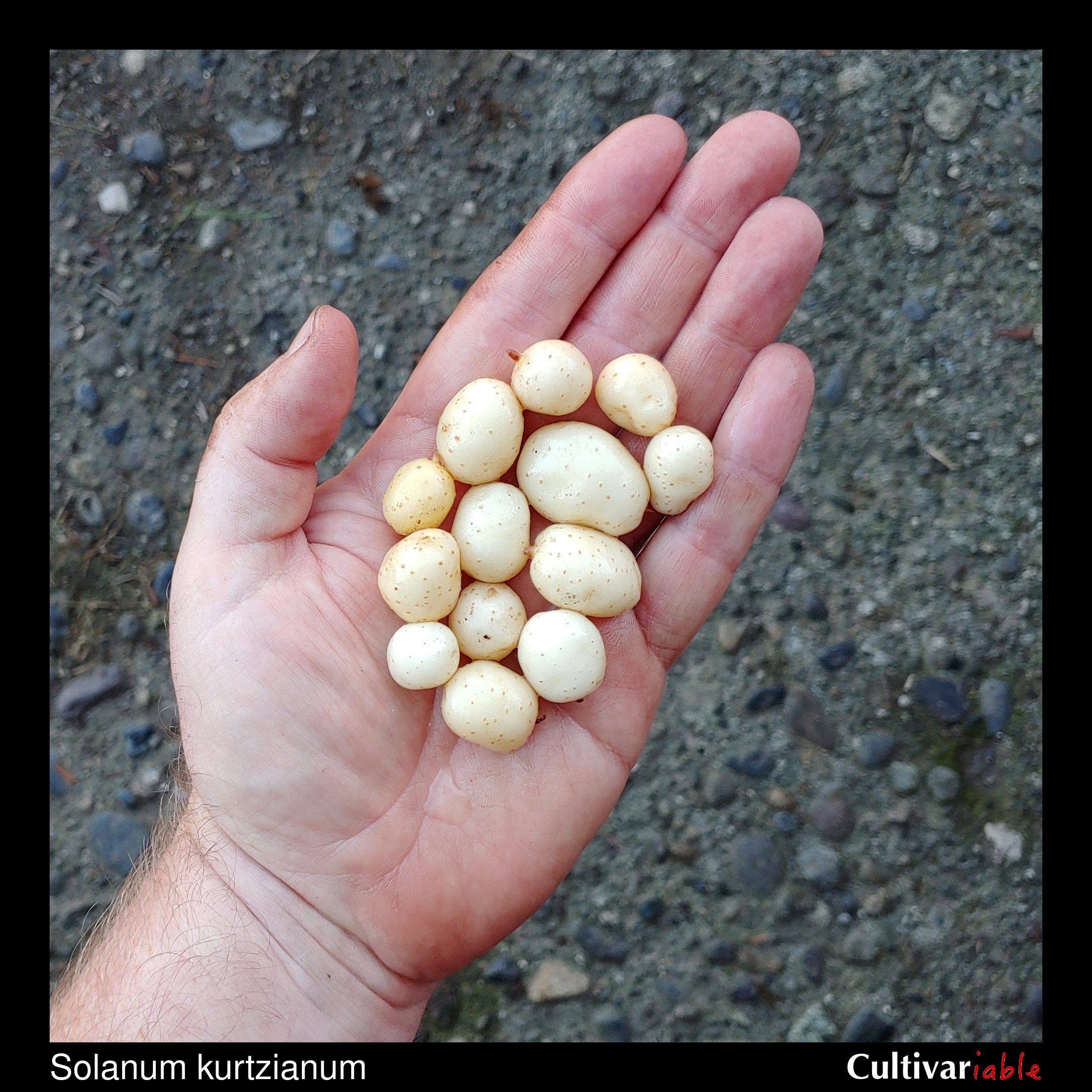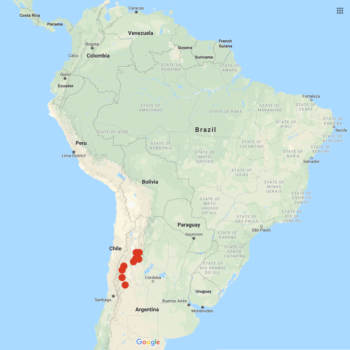Solanum kurtzianum

| Common Names | |
| Code | ktz |
| Synonyms | S. improvidum, S. macolae, S. ruiz-lealii, S. velascanum |
| Clade | 4 |
| Series | Tuberosa |
| Ploidy | Diploid (2x) |
| EBN | 2 |
| Tuberization Photoperiod | Short Day |
| Self-compatibility | No |
| Nuclear Genome | A |
| Cytoplasmic Genome | Unknown |
| Citation | Bitter & Wittmack: Bot. Jahrb. Syst. 50, Beibl. 548. 1914. |
Description

Solanum kurtzianum (kurtzianum, in honor of German botanist Fritz Kurtz) is a wild potato species from Argentina.
The specific epithet, kurtzianum, honors German botanist Fritz Kurtz. While there is no completely standardized pronunciation for scientific names, the most common way to pronounce this species is probably so-LAY-num kurt-zee-AN-um.
Subramanian (2017) found that at least some accessions of this species have unusually low calcium and potassium content and extremely high dry matter.
Resistances
This species can survive frosts down to 26 degrees F (-3.5 C) (Li 1977). Vega (1995) found that this species is less frost tolerant than domesticated potato.
In an in vitro test of 10 wild diploid species, S. kurtzianum was one of the most heat resistant and yielded more under warm temperatures (Guedes 2019).
| Condition | Type | Level of Resistance | Source |
|---|---|---|---|
| Alternaria solani (Early Blight) | Fungus | Somewhat resistant | Jansky 2008 |
| Drought | Abiotic | Somewhat resistant | Machida-Hirano 2015 |
| Frost | Abiotic | Somewhat resistant | Machida-Hirano 2015 |
| Fusarium sambucinum (Fusarium Wilt) | Fungus | Not Resistant | Lynch 2003 |
| Globodera pallida (Pale Cyst Nematode) | Invertebrate | Somewhat resistant | Castelli 2003 |
| Globodera pallida (Pale Cyst Nematode) | Invertebrate | Not resistant | Bachmann-Pfabe 2019 |
| Globodera rostochiensis (Potato Cyst/Golden Nematode) | Invertebrate | Somewhat resistant | Castelli 2003 |
| Heat | Abiotic | Somewhat resistant | Machida-Hirano 2015 |
| Leptinotarsa decemlineata (Colorado Potato Beetle) | Invertebrate | Somewhat resistant | Machida-Hirano 2015 |
| Meloidogyne spp. (Root Knot Nematode) | Invertebrate | Somewhat resistant | Machida-Hirano 2015 |
| Pectobacterium carotovorum (Blackleg/Soft Rot) | Bacterium | Somewhat resistant | Chung 2011, Machida-Hirano 2015 |
| Phytophthora infestans (Late Blight) | Fungus | Not resistant | Bachmann-Pfabe 2019 |
| Potato Leaf Roll Virus (PLRV) | Virus | Somewhat resistant | Machida-Hirano 2015 |
| Potato Virus Y (PVY) | Virus | Somewhat resistant | Cai 2011 |
| Synchytrium endobioticum (Wart) | Fungus | Somewhat resistant | Machida-Hirano 2015 |
Glykoalkaloid content
No information.
Images
 |
|||
Cultivation
I have found this species difficult to germinate. It might require conditions different than the standard for S. tuberosum.
Towill (1983) found that seeds of this species stored at 1 to 3 degrees C germinated at 72 to 96% after 26 years.
Bamberg (1995) found that at least some accessions of S. kurtzianum are able to produce a significant amount of viable pollen even when temperatures exceed 100 degrees F for several hours during the day. Flowering was reduced under these conditions.
Breeding
Jackson (1999) found 6% 2n pollen from varieties of this species.
Crosses with S. tuberosum
This species was used in the breeding of the variety ‘Conestoga’ (Love 1999).
| Female | Male | Berry Set |
Seed Set | Germ | Ploidy | Source |
|---|---|---|---|---|---|---|
| S. kurtzianum | S. tuberosum | None | None | Jackson (1999) | ||
| S. tuberosum | S. kurtzianum | None | None | Jackson (1999) |
Crosses with other species
| Female | Male | Berry Set |
Seed Set | Germ | Ploidy | Source |
|---|---|---|---|---|---|---|
| S. commersonii |
S. kurtzianum |
Yes | Yes | Yes | Perlova 1945 |
References
Solanum kurtzianum at Solanaceae Source
